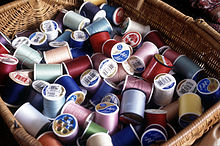ᱥᱩᱛᱟᱹᱢ


ᱥᱩᱛᱟᱹᱢ (yarn) ᱫᱚ ᱢᱤᱫ ᱯᱟᱛᱞᱟ ᱛᱚᱞ ᱞᱮᱠᱟᱱᱟᱜ ᱛᱚᱸᱛᱩ ᱡᱟᱦᱟᱸ ᱫᱚ ᱥᱤᱭᱟᱹᱣ. ᱞᱟᱹᱜᱤᱫ ᱠᱟᱹᱢᱤ ᱠᱚᱨᱮ ᱞᱟᱜᱟᱣᱜ ᱠᱟᱱᱟ᱾ᱱᱚᱶᱟ ᱫᱚ ᱞᱩᱢᱟᱝ, ᱱᱟᱭᱞᱚᱱ, ᱠᱟᱥᱠᱚᱢ ᱟᱨ ᱟᱭᱢᱟ ᱞᱮᱠᱟᱱᱟᱜ ᱠᱷᱚᱱ ᱵᱟᱱᱟᱜ ᱠᱟᱱᱟ᱾
ᱵᱮᱵᱚᱥᱛᱟ ᱠᱚ[ᱥᱟᱯᱲᱟᱣ | ᱯᱷᱮᱰᱟᱛ ᱥᱟᱯᱲᱟᱣ]
ᱥᱩᱛᱟᱹᱢ ᱫᱚ ᱢᱤᱫ ᱞᱮᱠᱟᱱᱟᱜ ᱥᱤᱭᱟᱹᱮ ᱥᱮ ᱛᱚᱞ ᱞᱮᱠᱟᱱᱟᱜ ᱡᱤᱱᱤᱥ ᱠᱟᱱᱟ᱾ ᱱᱚᱣᱟ ᱫᱚ ᱮᱴᱟᱜᱟᱜ ᱛᱚᱞ ᱡᱤᱱᱤᱥ ᱠᱷᱚᱱ ᱦᱚᱸ ᱵᱟᱝ ᱛᱚᱯᱟᱜᱚᱜ-ᱟ ᱟᱹᱰᱤ ᱜᱮ ᱠᱮᱴᱮᱡᱟ᱾ ᱱᱚᱣᱟ ᱛᱮ ᱟᱭᱢᱟ ᱞᱮᱠᱟᱱᱤᱡ ᱠᱚ ᱡᱚᱲᱟᱣ ᱦᱩᱭ ᱫᱟᱲᱮᱭᱟᱜ -ᱟ᱾ ᱡᱩᱫᱤ ᱱᱚᱶᱟ ᱨᱮ ᱟᱹᱭᱠᱟᱹᱣᱜ ᱞᱮᱠᱟᱛᱮ ᱮᱴᱟᱜ ᱡᱤᱱᱤᱥ ᱠᱚᱦᱚᱸ ᱠᱷᱚᱱ ᱵᱟᱝ ᱛᱚᱯᱟᱜᱚᱜ-ᱟ᱾ ᱱᱚᱶᱟ ᱛᱮᱫᱚ ᱞᱩᱜᱽᱲᱤᱜ ᱡᱷᱚᱞᱟ ᱮᱢᱟᱱ ᱠᱚ ᱵᱟᱱᱟᱣ ᱥᱮ ᱥᱤᱭᱟᱹᱮ ᱠᱚᱨᱮ ᱞᱟᱜᱟᱣᱜ ᱠᱟᱱᱟ᱾ ᱱᱚᱶᱟ ᱠᱷᱚᱱ ᱟᱭᱢᱟ ᱞᱮᱠᱟᱱᱟᱜ ᱡᱤᱱᱤᱥ ᱠᱚ ᱵᱟᱱᱟᱣᱜ ᱠᱟᱱᱟ᱾ ᱟᱨ ᱫᱚᱨᱠᱟᱨᱟ ᱡᱮᱞᱮᱠᱟ ᱺᱼ upholstery, car seating, tarpaulins, tents, ᱟᱨ saddlery
| Material | Description | Purpose |
|---|---|---|
| Cotton | Spun traditional thread | general |
| Cotton/polyester | A cotton thread with a polyester core which is slightly stretchy but retains the traditional look of cotton | strength without sheen |
| Fusible | Fuses sewn fabrics together when ironed | binding and appliqué |
| Linen | A spun thread, typically in a thicker gauge than that used for fabric garments. It may be waxed for durability and resistance to mildew. | Traditional leather saddlery; leather luggage, handbags, and accessories; and beadwork. |
| Metallics | A delicate metallic coating protected by an outer coating providing extremely vibrant color/glitter and/or texture. | decoration |
| Nylon | A transparent monofillament which can be melted by an iron. Nylon is usually stronger than polyester. | strength with transparency |
| Polyester | A synthetic blend which is stronger and stretchier than cotton with little or no lint (may be texturized) | strength |
| Rayon | Made from cellulose, but not considered to be a natural fibre because it is highly processed. Useful for obtaining bright colors, though not always color-fast. | high sheen, soft texture |
| Silk | A very fine, strong and hard-to-see thread; tends to degrade over time, however. | high strength and often high sheen, used for attaching beads |
| Wool | A thicker thread. | homespun look, rougher texture, highly insulating, water absorbent |
| Water-soluble | Dissolves when washed | temporary basting |
Polyester/polyester core spun thread is made by wrapping staple polyester around a continuous polyester filament during spinning and plying these yarns into a sewing thread. Core Spun Thread
Different weights[ᱥᱟᱯᱲᱟᱣ | ᱯᱷᱮᱰᱟᱛ ᱥᱟᱯᱲᱟᱣ]
ᱥᱩᱛᱟᱹᱢ gauges[ᱥᱟᱯᱲᱟᱣ | ᱯᱷᱮᱰᱟᱛ ᱥᱟᱯᱲᱟᱣ]
Yarns are measured by the density of the yarn, which is described by various units of textile measurement relating to a standardized length per weight. These units do not directly correspond to thread diameter.
Wt and Gunze count[ᱥᱟᱯᱲᱟᱣ | ᱯᱷᱮᱰᱟᱛ ᱥᱟᱯᱲᱟᱣ]
The most common weight system specifies the length of the thread in kilometres required to weigh 1 kilogram. Therefore, a greater weight number (indicated in the American standard by the abbreviation wt) indicates a thinner, finer thread. The American standard of thread weight was adopted from the Gunze Count standard of Japan which uses two numbers separated by a forward slash. The first number corresponds to the wt number of the thread and the second number indicates how many strands of fiber were used to compose the finished thread. It is common to wrap three strands of the same weight to make one thread, though this is not a formal requirement in the US standard (which is therefore less informative).
| Weight | Gunze Count | Common Use[᱒] | |
|---|---|---|---|
| Light | 60 wt | #60/3 | bobbin or appliqué |
| Thin | 50 wt | #50/3 | bobbin or appliqué |
| Regular | 40 wt | #40/3 | Quilting |
| Upholstery | 30 wt | #30/3 | Decorative |
| Heavy | 20 wt | #20/3 | Decorative |
| Converting From | Converting To | Method |
|---|---|---|
| Weight | Denier | 9000 / weight |
| Weight | Tex | 1000 / weight |
| Denier | Weight | 9000 / denier |
| Denier | Tex | denier / 9 |
| Tex | Denier | tex x 9 |
| Tex | Weight | 1000 / tex |
- Eisengarn ('iron yarn')
- Hank (textile)
- Sewing needle
- Staple (textiles)
- Stitch (textile arts)
- ↑ "Thread Tips - Threads for Quilters". Quilting.about.com. 2011-10-16. Retrieved 2011-11-30.
- ↑ "How to choose the right thread for your project and your sewing machine". Quiltbug.com. Retrieved 2011-11-30.
